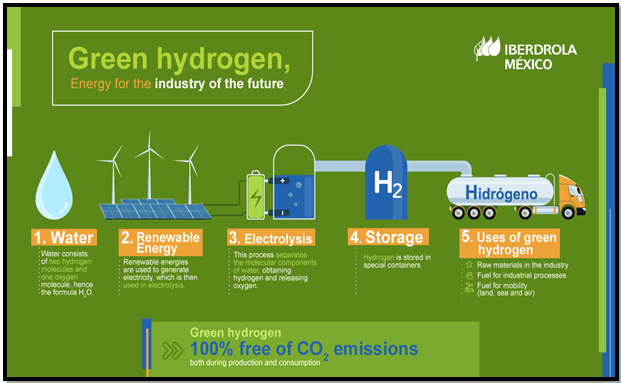HYDROGEN’S CHALLENGE IN DECARBONIZING INDUSTRY
Syllabus:
GS 3:
- Science and Technology- Developments and their Applications and Effects in Everyday Life..
- Infrastructure: Energy.
Why in the News?
The decarbonization of hydrogen production is a critical focus area as global industries seek cleaner alternatives to reduce carbon emissions. Recent developments indicate that despite the promise of green hydrogen, cost barriers and the rise of blue hydrogen have hindered its widespread adoption. This raises concerns about the future of green hydrogen in achieving industrial decarbonization.
Source: Iberdrola Mexico
Overview and Context:
- Hydrogen’s Promise: Hydrogen was once seen as a potential game-changer in decarbonizing industries like steel, cement, and petrochemicals, which contribute significantly to global carbon emissions.
- Green Hydrogen’s Struggle: Despite hopes, less than 0.1% of hydrogen produced today is “green,” made by splitting water with electricity. Most hydrogen remains “grey,” derived from fossil fuels, emitting large amounts of carbon.
- Cost Challenges: Green hydrogen has not seen the cost reductions observed in other clean technologies. In fact, production costs in the U.S. have risen to nearly $5 per kg, far from the $1 per kg target needed to compete with natural gas.
- Global Setbacks: The EU’s efforts to build a green hydrogen supply chain have faced challenges, with auction bids for green hydrogen significantly higher than fossil fuel-based alternatives.
- Big Oil’s Advantage: “Blue hydrogen,” which captures carbon during production, is gaining ground due to lower costs and the financial backing of the oil industry, putting green hydrogen at a disadvantage.
Hydrogen Overview
Types of Hydrogen Grey Hydrogen:
Blue Hydrogen:
Green Hydrogen:
|
The Rise of Blue Hydrogen
- Partial Decarbonization: Blue hydrogen reduces emissions by 60-70% compared to grey hydrogen. While not perfect, it appeals to consumers seeking cleaner options without the higher costs of green hydrogen.
- Oil Industry’s Influence: Major oil companies like Aramco, BP, and Shell are heavily investing in blue hydrogen projects, leveraging their financial resources and existing infrastructure to dominate the market.
- Project Development: By 2030, over half of the planned green hydrogen projects are still in early development stages, making them vulnerable to cancellation. In contrast, blue hydrogen projects are advancing more rapidly.
- Investment Shift: Blue hydrogen is currently positioned to lead in the market, as green hydrogen struggles to scale up and meet existing demand, let alone future growth.
- Limited Impact: While blue hydrogen is an improvement over grey, it may not be sufficient to meet the broader goals of decarbonizing entire industries, leaving green hydrogen’s promise unfulfilled.
The Role of Innovation in Hydrogen’s Future
- Technological Advancements: Continued innovation in electrolyzer efficiency, materials science, and hydrogen storage is crucial for reducing the cost of green hydrogen
- Research and Development: Increased investment in R&D can lead to breakthroughs that make green hydrogen more competitive with fossil fuels, potentially lowering costs and improving scalability.
- Public-Private Partnerships: Collaborations between governments, research institutions, and private companies can accelerate the development of cutting-edge hydrogen technologies.
- Alternative Production Methods: Exploring alternative methods of hydrogen production, such as using bio-waste or advanced nuclear reactors, could provide additional pathways to cost-effective green hydrogen.
Global Collaboration:
International cooperation on hydrogen innovation can help share knowledge, reduce costs, and create a more robust global market for green hydrogen technologies.
Challenges in Scaling Green Hydrogen
- Policy Shortcomings: Existing government policies focus on subsidizing producers rather than mandating the use of green hydrogen by major consumers, unlike the demand-side support that spurred the renewable energy boom.
- Trade and Cost Barriers: Trade tensions have made developers hesitant to purchase cheaper Chinese-made electrolyzers, which could reduce production costs significantly, but are underutilized due to geopolitical concerns.
- Financial Hurdles: High interest rates and uncertain government support have deterred investment in green hydrogen, making it a risky bet for many investors.
- Chicken-Egg Problem: The development of green hydrogen faces a series of interconnected challenges, similar to those faced by solar, wind, and battery technologies in their early stages.
- Potential Solutions: To overcome these challenges, a combination of lower interest rates, stronger political will, and strategic policy interventions is needed to replicate the success seen in other clean energy sectors.
The Path Forward for Green Hydrogen
- Learning from Renewables: The success of solar power, wind energy, and electric vehicles shows that with the right support, even challenging technologies like green hydrogen can become viable.
- Big Oil’s Role: In the absence of sufficient political will, the oil industry is poised to lead the hydrogen market with blue hydrogen, which, while not perfect, offers a cleaner alternative to current practices.
Strategic Investments:
Governments need to focus on both supply-side and demand-side incentives, ensuring that green hydrogen can compete on a level playing field with fossil fuel-based alternatives.
- Long-Term Vision: Achieving the potential of green hydrogen requires long-term commitment, reducing trade barriers, and making strategic investments in research and development.
- Balancing the Market: To ensure a sustainable future, a balanced approach that encourages both green and blue hydrogen development is essential, ensuring that the benefits of hydrogen are fully realized across all industries.
Conclusion
The promise of green hydrogen remains unfulfilled due to high costs, slow progress, and competition from blue hydrogen. Overcoming these challenges requires stronger government policies, technological innovation, and reduced financial barriers, ensuring that green hydrogen can play a significant role in global decarbonization efforts.
Source:Mint
Mains Practice Question
Discuss the challenges and potential of green hydrogen in achieving global decarbonization goals. How can India leverage this technology to transition towards a low-carbon economy?
Associated:
https://universalinstitutions.com/national-green-hydrogen-mission/




